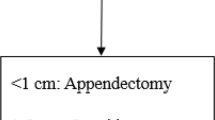Abstract
Background
Appendiceal neuroendocrine tumors (A-NETs) are rare neoplasms of the GI tract. They are typically managed according to tumor size; however, the impact of surgical strategy on the short- and long-term outcomes is unknown.
Methods
All patients who underwent resection of A-NET at 8 institutions from 2000 to 2016 were analyzed retrospectively. Patient clinicopathologic features and outcomes were stratified according to resection type.
Results
Of 61 patients identified with A-NET, mean age of presentation was 44.7 ± 16.0 years and patients were predominantly Caucasian (77%) and female (56%). Mean tumor size was 1.2 ± 1.3 cm with a median of 0.8 cm. Thirty-one patients (51%) underwent appendectomy and 30 (49%) underwent colonic resection. The appendectomy group had more T1 tumors (87% vs 42%, p < 0.01) than the colon resection group. Of patients in the colon resection group, 27% had positive lymph nodes and 3% had M1 disease. R0 resections were achieved in 90% of appendectomy patients and 97% of colon resection patients. Complications occurred with a higher frequency in the colon resection group (30%) compared with those in the appendectomy group (6%, p = 0.02). The colon resection group also had a longer length of stay, higher average blood loss, and longer average OR time. Median RFS and OS were similar between groups.
Conclusion
A-NET RFS and OS are equivalent regardless of surgical strategy. Formal colon resection is associated with increased length of stay, OR time, higher blood loss, and more complications. Further study is warranted to identify patients that are likely to benefit from more aggressive surgery.

Similar content being viewed by others
References
Mehrvarz Sarshekeh AM, Advani S, Halperin DM, et al. Regional lymph node involvement and outcomes in appendiceal neuroendocrine tumors: a SERR database analysis. Oncotarget. 2017;8(59):99541–99551.
Niederle MB, Hackl M, Kaserer K, et al. Gastroenteropancreatic neuroendocrine tumours: the current incidence and staging based on the WHO and European Neuroendocrine Tumour Society classification: an analysis based on prospectively collected parameters. Endocr Relat Cancer. 2010;17(4):909–18.
Sandor A, Modlin IM. A retrospective analysis of 1570 appendiceal carcinoids. Am J Gastroenterol. 1998;93(3):422–428.
Rault-Petit B, Do Cao C, Guyétant S, et al. Current management and predictive factors of lymph node metastasis of appendix neuroendocrine tumors: a national study from the French Group of Endocrine Tumors (GTE). Ann Surg. 2018. Epub ahead of print
Rindi G, Arnold R, Bosman FT, et al. Nomenclature and classification of neuroendocrine neoplasms of the digestive system. In: Bosman FT, Carneiro F, Hruban RH, Theise ND (eds.) WHO classification of tumors of the digestive system. Lyon: IARC 2010.
Mullen JT, Savarese DM. Carcinoid tumors of the appendix: a population-based study. J Surg Oncol. 2011;104:41–44.
Dogwin JD 2nd. Carcinoid tumors. Analysis of 2,837 cases. Cancer: 1975;36:560–69.
Moertel CG, Weiland LH, Nagorney DM, et al. Carcinoid tumor of the appendix: treatment and prognosis. N Engl J Med. 1987;317(27):1699–701.
Murray SE, Lloyd RV, Sippel RS, et al. Postoperative surveillance of small appendiceal carcinoid tumors. Am J Surg. 2014;207(3):342–5.
Komminoth PA, Capella C, Klimstra DS, et al. WHO classification of tumours of the digestive system. 4th ed. IARC Press; Lyon: 2010. Neuroendocrine neoplasms of the appendix.
La Rosa S, Marando A, Furlan D, et al. Colorectal poorly differentiated neuroendocrine carcinomas and mixed adenoneuroendocrine carcinomas: insights into the diagnostic immunophenotype, assessment of methylation profile, and search for prognostic markers. Am J Surg Pathol. 2012;36(4):601–611.
Brathwaite S, Rock J, Yearsley MM, et al. Mixed-adeno-neuroendocrine carcinoma: an aggressive clinical entity. Ann Surg Oncol;2016:23(7):2281–2286.
Kulke MH, Shah MH, Benson AB, et al. Neuroendocrine tumors, version 1.2015 J Natl Compr Canc Netw. 2015;13(1):78–108.
Bernick PE, Klimstra DS, Shia J, Minsky B, Saltz L, Shi W, Thaler H, Guillem J, Paty P, Cohen AM, Wong WD. Neuroendocrine carcinomas of the colon and rectum. Dis Colon Rectum. 2004; 47:163–69.
Welin S, Sorbye H, Sebjornsen S, Knappskog S, Busch C, Oberg K. Clinical effect of temozolomide-based chemotherapy in poorly differentiated endocrine carcinoma after progression on first-line chemotherapy. Cancer. 2011; 117:4617–22.
Pape UF, Perren A, Niederle B, Gross D, Gress T, Costa F, Arnold R, Denecke T, Plöckinger U, Salazar R, Grossman A, and Barcelona Consensus Conference participants. ENETS Consensus Guidelines for the management of patients with neuroendocrine neoplasms from the jejuno-ileum and the appendix including goblet cell carcinomas. Neuroendocrinology. 2012; 95:135–56.
Boudreaux JP, Klimstra DS, Hassan MM, Woltering EA, Jensen RT, Goldsmith SJ, Nutting C, Bushnell DL, Caplin ME, Yao JC, and North American Neuroendocrine Tumor Society (NANETS). The NANETS consensus guideline for the diagnosis and management of neuroendocrine tumors: well-differentiated neuroendocrine tumors of the Jejunum, Ileum, Appendix, and Cecum. Pancreas. 2010; 39:753–66.
Neuroendocrine Tumors. In: Edge SB, Byrd DR, Compton CC, Fritz AG, Greene FL, III AT, editors. AJCC Cancer Staging Manual. 7th edn New York: Springer; 2010. p. 181-5.
Author information
Authors and Affiliations
Corresponding author
Ethics declarations
Institutional Review Board (IRB) approval was obtained at each institution.
Additional information
Publisher’s Note
Springer Nature remains neutral with regard to jurisdictional claims in published maps and institutional affiliations.
Rights and permissions
About this article
Cite this article
Crown, A., Simianu, V.V., Kennecke, H. et al. Appendiceal Neuroendocrine Tumors: Does Colon Resection Improve Outcomes?. J Gastrointest Surg 24, 2121–2126 (2020). https://doi.org/10.1007/s11605-019-04431-6
Received:
Accepted:
Published:
Issue Date:
DOI: https://doi.org/10.1007/s11605-019-04431-6




